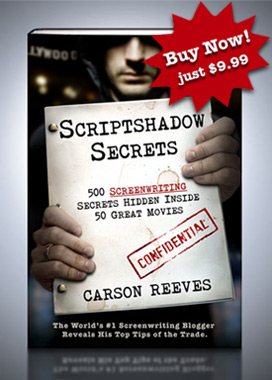Genre: Comedy
Premise: (from Black List) After she catches her boyfriend cheating, Liv goes on a social media tirade that lands her in court for slander, and the judge forces her to make amends by composing one positive comment for every negative comment she posted, while under the supervision of a reclusive mediator also on the rebound from a failed relationship. Inspired by true events.
About: This script finished on last year’s Black List with 9 votes. The script got writer Erin Rodman a job writing “The Bear,” an upcoming movie about a high school teen who uses her school’s bear mascot costume to become a viral sensation, but is afraid to tell everyone who she really is.
Writer: Erin Rodman
Details: 102 pages
I find social media to be the technological embodiment of evil (which is why I’m no longer on it). Since no one has to look anyone in the face in a virtual conversation, people say the worst things to each other. But that’s not even the bad part. The bad part is that a whole generation of kids are growing up THINKING THIS IS NORMAL! That yelling at people over Twitter is a normal thing you should engage in and take with you into your adult life. I’m hoping the planet comes to its senses at some point and figures out a way to make social media kinder. But I’m not holding my breath. In the meantime, we have people like Erin Rodman exploring the idea through a screenplay. Let’s see if it’s any good.
Social media-obsessed Liv is a party organizer in Vegas, mainly for bachelorette parties. She’s currently growing her business at a rapid rate, when she comes home one day and finds her boyfriend, Austin, in bed with some chick name Shinee.
Liv is enraged. So much so that she starts drinking and begins an epic night of social media bashing her now ex. She writes on his Facebook page. His instagram. She e-mails all his friends and family members, telling them all sorts of things about Austin’s underwhelming sexual prowess. We’re talking HOURS of messages here.
The next day Liv wakes up and… isn’t resentful at all. She’s proud of what she’s done. But she’s about to get a reality check because she’s served with papers. Yes, Austin has sued her for slandering him all over the internet! Cut to a court room where the judge informs Liv that either she pay Austin 100 grand or she apologize and post 100 nice things about Austin online to make up for every non-nice thing. To that Liv says…. F OFF!
But cooler heads prevail when Liv’s lawyer informs her that as much as she hates the idea of writing nice things about her ex, it’s better than writing a check for 100 thousand dollars. Liv isn’t so sure but she decides to give it a try. She talks to friends, family, polls random people in the club – trying to find any generic nice thing she could say. But she turns down every suggestion because they aren’t true.
With time running out, Liv realizes that the judge didn’t say she had to compliment Austin specifically. Just their relationship. So she’s able to find 100 things in their relationship that helped make her a better person (stuff like, since you weren’t around, I could focus on my business and get better at that). So, in the end, our Liv wins. And, in the process, becomes a slightly better person. Very slightly.
I can see why Say Something Nice got Black List votes even if I didn’t personally like it. The voice here is strong. By the way, scripts that get the same rating on here aren’t always exactly the same. For example, if you contrast this script with last week’s comedy, Assisted Living, this writer is one million times better than that writer. It’s not even close. Assisted Living felt like it was written by someone who learned screenwriting in January. Rodman has much more control over the craft.
But Say Something Nice still didn’t work for me and it’s because it suffers from something we only talk about generally. Today we’re going to give it a name. UPP. Otherwise known as the Unlikable Protagonist Paradox.
UPP works like this. You need to give your protagonist a negative trait – known as their ‘fatal flaw’ – in order for the character to arc over the course of the story. If your character doesn’t have anything wrong with them, there’s nothing for them to learn, and therefore there’s no change. Not every character needs to change. But most of them, in this form of storytelling known as screenwriting, do.
The paradox comes in that if a person’s defining characteristic is negative, the reader is prone to disliking them. Unlikable heroes are one of the fastest ways to lose a reader. Because why would we root for someone we hate? And there is no middle ground here. Liv is hateable. I mean this is a girl who’s more angry about the fact that she has to take down instagram photos of her boyfriend because she looks good in those photos, than, you know, that she just lost her boyfriend.
The solution to UPP is actually quite simple. Focus on ONE flaw. Not a ton of them. Just one. The more unlikable traits you dump onto your hero, the less we’ll like them. Liv is a drunk, she’s vindictive, she’s a liar, she’s mean-spirited, she’s selfish, she’s image-obsessed, and worst of all, she likes puns. It’s negativity overload. Here’s a line from Liv in the script, which is par for the course: “This isn’t about fast, Daisy. This is about winning. Everyone’s against me. But they underestimate me. I’m coming for them now. I’m fucking Wonder Woman.”
I get that that’s the point of the concept – a nice person would never have written all these mean things about her boyfriend. But character consistency doesn’t matter if we hate your character.
Focus on one negative thing for your hero’s flaw. Like selfishness, for example. This is what Groundhog Day did. Phil was selfish. That was his flaw. Period. And, look, you can still go negative with that flaw. You can go all in on it. You just can’t pile on a bunch of other negative things.
Unfortunately, there’s an additional component to character like-ability that can’t be measured. And that’s FEEL. How the reader FEELS about the character. It’s no different from real life. There are people you just don’t like and you don’t know why. That happens to readers too. Liv is one walking complaint in this movie. She’s always complaining about something. And always playing the victim. I got annoyed listening to her.
Some of you may wonder, well then Carson, how come the script got 9 votes and landed on the Black List? Well here’s the thing. You can still pull in a crowd of people who relate to someone. If I just came off a breakup and found out my ex cheated, I would be in that angry headspace that Liv is in. So I would relate to and understand her better. You’re going to get those people. But I believe character likability trumps that. You don’t want to have to scrape readers off the angry scrap pile to be the main cheerleaders for your script. You should be aiming for a wider audience.
Another problem with this script is that it embraces this punk rock rebel approach in making its heroine so unlikable, yet uses cheesy 80s movie tropes to form its backbone. The goofy court mandate. You’ve got to say 100 nice things (so specific). You’ve got 30 days to do so. Our hero falls in love with the jerk she hated in Act 1. This is the kind of Blake Snyder stuff that’s passed the screenwriting world by. It’s too transparent. But more importantly, it clashes with the edgy sensibility the writer is trying to push through her main character.
Again, this script isn’t bad. But it’s more of a showcase for the writer than it is a script that’s good by itself.
[ ] What the hell did I just read?
[x] wasn’t for me
[ ] worth the read
[ ] impressive
[ ] genius
What I learned: If you have a strong voice, especially in the dialogue department, you don’t have to write a great concept or even a perfect execution of that concept. You just need an idea that’s clear and that gives you room to play with for what you do best. The script, then, becomes more of a container to display your voice than a great story. That’s how I see Say Something Nice. The setup is contrived. The execution feels like it was discovered in a 1988 Paramount garbage can. But Liv is a lively character who, like her or hate her, makes an impression. She definitely has pop. And if your main character has pop, producers who read endless piles of boring scripts with boring characters are going to remember you. That’s why this script made the Black List.
Genre: Thriller
Premise: A boy on the run in the endless Montana forest teams up with a smokejumper to escape two evil brothers intent on killing him.
About: This is based on the successful novel of the same name. The author of the novel, Michael Koryta, wrote the original screenplay adaptation. Then Charles Levitt was brought in (In the Heart of the Sea). And finally, in an indication that the producers felt they had something special, the ultra-expensive Taylor Sheridan (Sicario). This is his draft.
Writers: Taylor Sheridan (previous drafts by Michael Koryta and Charles Levitt), based on the novel by Michael Koryta
Details: 92 pages
The following is a phone call I received 14 years ago.
“Hello?”
“Hi, Carson? My name is Script Maven. I’m calling to make you an offer.”
“I’m sorry, I’m not interested—“
“Wait! Before you hang up. What if I told you that I could offer you two of the best villains that have ever been written for your next screenplay.”
“Uh-huh. What else are you offering? A screenwriting Academy Award?”
“Oh no, Carson. This is real. I have two villains who are so nasty people will be talking about them for years, decades even. They have names ready to go – Jack and Patrick.”
“Listen pal. I’m currently working on my masterpiece right now. A little script called Tom and Andy Build an Opera House. I clearly don’t need any help on the screenwriting front.”
“Carson, this is the last time I can offer you this. These characters will change your life. Studios will pay you 7 figures on a routine basis to fix their villain characters after this movie comes out.”
“Uh-huh. Nice try. Go sell your snake oil somewhere else, Script Maven. You’re the real villain here. A time-stealing villain. Seeya!”
Up until today, I never felt bad about giving up on that phone call. But the chickens have finally come home to roost. Through dedication and sheer force of will, Script Maven has sold his two villain characters. To these three writers. Because Jack and Patrick very well might be two of the best villains in history.
40 year old Owen is a forensic analyst. And he just found something out that could implicate huge swaths of the government. For this reason, Owen grabs his 12 year old son, Connor, and heads out of the city. What’s going on, his son asks. Owen says that men will be coming to kill him. They need to get far away then find access to a TV station so he can reveal the information he has to the world. That’s the only way they live.
Meanwhile, we meet Hannah. In addition to being the most common name for female protagonists, Hannah is a smokejumper. She goes into forest fires and helps get stranded people out. Except, recently, she made a terrible error which ended up killing three kids. Haunted by this mistake, she now does time in remote fire towers. It keeps her away from reality.
Finally, we meet Jack and Patrick. Sociopath brothers from hell. These nasty assassins were hired by the government to find Owen and kill him. And since Owen is with his son, kill him too. They successfully track them to Montana and shoot out their car in the middle of a hilly forest. Owen dies but Connor survives, darting into the trees.
Jack and Patrick realize that this is going to be harder than they thought. Lots of locals will need to become collateral damage. And since we can’t have a small town in the middle of nowhere all of a sudden have a 50,000% increased murder rate without drawing suspicion, the two do what any kind thoughtful brothers would do. They start a forest fire to wipe out all the people they’re going to kill.
Of course, that means Connor isn’t just running from these men. He’s running from a forest fire. Which is why he’s lucky he’s run into Hannah. I mean, if there’s one person you want to run into when you have a forest fire on your heels, it’s this woman. And she’s got something to prove considering the last time she was responsible for three children, they died a horrible fiery death.
But what Hannah is about to learn is that, for the first time in her profession, it isn’t the fire that’s the biggest danger. It’s these freaking psycho brothers – two maniacs who will stop at nothing to kill both Connor and her. Which means that, for once, she will have to use the fire as an ally.
Jack and Patrick are the stars of this movie. That’s my takeaway. The moment that sold me was after kidnapping the local sheriff to help them navigate the woods to find Hannah and Connor, Patrick tells the sheriff, after this is done, I’m going to kill you and your wife. The only thing in question is whether I do it fast or slow. If you do everything I say, I’ll make it fast.
These villains don’t even have the pretense to lie. Usually, you tell people what they want to hear (“If you do everything I say, I’ll let you live”) so they help you. These two don’t operate under that rule set. Their rule set is murder and destruction. Everything else is secondary.
My feeling is that if you write a hero we love or a villain we hate, it’s impossible to get below a “worth the read.” Because in both instances, the reader desperately wants something – for either the hero to win or the villain to fail. And they’ll read your whole script to see if that happens.
Now if you happen to write a hero we love AND a villain we hate, you’re probably in “impressive” territory. Even with a so-so plot, you’ve got your reader on a string via the two most important components of the story.
And I liked what these writers did with the hero – Hannah. I’ve realized there are two approaches you can take with your hero. You can make them the WORST possible people for the situation they’re in. Or you can make them the BEST. Both bring valuable assets to the screenwriting table.
If your hero is the worst person for the problem, every stage of the journey is difficult. And difficulty = drama. That’s where all the fun is. Drama. But there’s something fun about a character who’s perfectly suited for the problem as well, as Hannah is here. I think it’s because we enjoy seeing an expert operate in their field of expertise, especially when it’s something as theatrical as forest fires. We *want* to see all her little tricks she’s perfected in how to use the fire to her advantage.
Yet here is where Those Who Wish Me Dead fell short of impressive territory. While we get to see some of Hannah’s knowledge on display. We don’t get to see nearly enough. In fact, the final act can be SOOOOO much better than it is here. We need to lean ALL IN on the fire. Not halfway in.
It’s not rocket science. Figure out what’s unique about your premise then go ALL IN on that. What’s unique here is the firefighting aspect. So you don’t go 60% on the fire stuff in the end. You need to go 160%. Not only is that going to make the movie better. But it’s going to make your protagonist better. Seeing her work her fire wizardry is going to make us like her more.
Because Hannah’s got a high bar to live up to with these villains. Something always feels off if your villains are way more equipped than your heroes or vice versa.
I’ve been thinking a lot since finishing this script – what makes these villains so memorable compared to others? Cause most of the time, our brothers are just nasty. We’ve seen nasty villains before. What I realized was that, normally, we get a single sociopath villain. Which makes sense. He’s a sociopath. He’s isolated. He does his own thing. Two sociopathic brothers *who care about each other* offers something new. Because it directly contradicts the definition of being a sociopath.
Well, that and they’re both terrifying as hell.
This script came close to getting an impressive. But it ain’t going to get there until they ramp up this climax to a thousand.
Still a good script though! Sheridan continues his hot streak (no pun intended).
[ ] What the hell did I just read?
[ ] wasn’t for me
[xx] worth the read
[ ] impressive
[ ] genius
What I learned: The perfect balance for heroes and villains is that the villains should always be a little bit more capable than the hero. The reason for that is you want it to seem hard to defeat the villain. If your hero is clearly more capable than them, there’s no suspense. We already know they’re going to prevail.
Genre: Comedy
Premise: Best friends and former time travelers Bill and Ted are called back by the heavens to save the world. All they have to do is write a song that unites every single person on the planet. And they’ve got 77 minutes to do it.
About: They have been trying to make this movie forever. I think since the late 90s. But Keanu was becoming a huge star and didn’t have the time. I believe that changed when Keanu hit that rough patch, doing 10 years of DTV work. Finally, he had the time to do another Bill and Ted movie. Ironically, that’s right when his career picked back up again with John Wick. But Keanu kept his promise to his buddy Alex Winter and here we are. These are also the original screenwriters from Bill & Ted’s Excellent Adventure.
Writers: Chris Matheson and Ed Solomon
Details: 90 minutes
The Keanusance?
Is that what they’re calling it?
Hey, as long as I keep getting Matrix and John Wick movies, I’ll call it whatever you want me to. The Keanuback. Return of the Kean Bean. Kicking it with Keanu. Tune My Piano Keanu. Hmm… maybe not that last one.
Bill and Ted are in their 50s and still plugging away as the group, “Wild Stallyns.” But things aren’t going well. The former Billboard-topping Stallyns can barely get wedding gigs these days. To make matters worse, they were told as teens they would write the song that unites the world. Except they still haven’t written it! Here’s co-writer Solomon on this writing choice (via Daily Dead)…
“I’ve always felt that comedy is best when it comes from one of the more negative, let’s call it emotions: sadness, despair, anxiety, fear, whatever. And the guys were feeling those things. In a weird way, we said from the beginning, “Let’s make a feel-good comedy about failure. Let’s make an absurd, silly, ridiculous, funny movie about dashed dreams and disappointment. And let’s have it end where you feel really good.”
Bill and Ted are then visited by an agent of Heaven (I think Heaven?) and brought to the city in the clouds, where they’re informed by some queen woman that time is up. They must write the song that unites the world… WITHIN 77 MINUTES! Should they fail, time and space, which are already starting to implode, will cease to exist.
Freaked out, Bill and Ted have no idea how they’re going to write a song in 77 minutes that they’ve been trying, and failing, to write for 30 years. But they realize they have a hack. The time machine! They can go into the future and take the song FROM THEIR FUTURE SELVES, who have already saved the world. Isn’t that stealing, wonders Ted. “Not if we’re stealing… from ourselves,” Bill points out.
This begins a trip deeper and deeper into the future to find the Bills and Tedss who have written the song. But the more Bills and Teds they visit, the more they’re lied to. It seems like nobody has the song. Could it be that they actually have to figure it out for themselves??
Meanwhile, Bill’s and Ted’s excellent 20-something daughters, Billie and Thea, who happen to be aspiring musicians, sense that their dads are in trouble and hijack a second time travel machine where they go BACK in time and recruit some of the best musicians ever – Mozart, Jimmi Hendrix, Louis Armstrong, Kid Cudi – to help their dads. Of course, we begin to suspect that this crazy adventure was never about the dads in the first place. It was really about… THEM!
Oh, and let’s not forget that Heaven secretly needs to kill Bill and Ted so they create a killer robot and send him through time to chase and assassinate the Stallyns. You read that correctly. There’s a killer robot in this movie. So, can Billie and Thea save the world and, with it, their dads? By golly, I hope so.
Bill and Ted Face The Music will win you over by the end. But it sure tries its hardest to shoo you away in the meantime.
This was an odd project from the outset.
The fact that Keanu Reeves never makes sequels (that used to be his defining m.o.) yet he wanted to make a Bill and Ted threequel? Odd. Why Bill and Ted of all his properties? It’s not even like he made the first movie then wanted to revisit the fun of it, like Jim Carrey did with Dumb and Dumber Too. He’d already made a sequel.
As one of you pointed out after the latest Kevin Smith debacle (“Moochie and Spoochie Road Trip Shenanigans”), watching 20-somethings curse up a storm is funny. Watching 50-somethings do the same thing isn’t nearly as funny. Same problem here. Bill and Ted talking like dumb 20-somethings when they’re in their 50s makes for an uncomfortable experience.
Speaking of uncomfortable, did Keanu film all his scenes right after doing a day of John Wick stunt work? Why is he limping around half the time? Or struggling to walk from one end of the room to the other? It certainly doesn’t help sell the nonchalant “Yeah dude” persona he’s supposed to be exuding.
Something I realized while watching Face the Music, though, is that time travel works better with comedy than it does straight sci-fi. That’s because time travel never makes sense when you think about it. You go back in time to fix something but, by doing so, don’t you alter the course of history, essentially creating a second timeline? And doesn’t that mean the original timeline still burns? A butterfly flaps its wings and all that?
The nice thing about comedy is the audience doesn’t hold you to that same impossible standard. That’s because, in a comedy, laughing is more important to the audience than logic. In other words, you have more leeway.
But even Bill and Ted leaves you stumped at times with its time travel paradoxes. We’re told they only have 77 minutes to find the greatest song ever (the “U” in GSU – “Urgency”) yet they can travel through time. So doesn’t that mean they have unlimited minutes? Why does every minute that passes during time travel equal an actual minute in Heaven? Isn’t Heaven timeless?
Again, it’s annoying, but if you’re laughing, it doesn’t matter.
And Face the Music starts making you laugh later when it loosens the reigns. The daughters are surprisingly fun to watch, especially the one who plays Ted’s daughter. She somehow both sounds exactly like Keanu circa 1991 and adds her own weird take to the impersonation. I also loved Death’s scenes. One of my favorite lines is when they catch him playing hopscotch by himself and Ted realizes, “He’s cheating!” Death cheating at hopscotch when no one else is around is hilarious. But my favorite character was the one I initially hated the most – the killer robot. Once he fails at his mission and just wants to be one of the guys, I fell in love with him. He was so funny.
Also, some movies are lucky to come out at the exact time they’re needed. And Face the Music fits that description to a tee. Things are a bit charged up in our world to say the least. Having two goofballs go on a mission to unite the planet… well that’s a bit serendipitous don’t you think? Even the subpar “song that unites the world” couldn’t derail the good vibes that flowed from the final scene.
The strangest thing about this movie is that it tells us nothing about the movie business. It’s such an outlier in so many ways that it’s hard to formulate any “larger picture” thoughts on the film. And maybe that’s the point. This movie was made for one purpose and one purpose only – to bring a smile to your lips. And at that, it succeeds.
[ ] What the hell did I just read?
[ ] wasn’t for me
[x] worth the rental (at 6 dollars, not 20 dollars)
[ ] impressive
[ ] genius
What I learned: When you write comedy, you have to be willing to take chances on the absurd. Comedy is the one thing in writing that you can’t argue with logic. Something is either funny or it isn’t. So if you’re stringently controlling every joke you write so that it works on a technical level, expect audiences to be unimpressed. A killer robot makes ZERO SENSE in this movie. It’s a “way out there” idea. But it ends up being the most interesting and funniest part of the movie. So play with absurd ideas in comedy. That doesn’t mean some of them won’t be stupid and you shouldn’t come to your senses and ditch them later. But if a joke/choice shouldn’t technically be working yet it is? Don’t question why. Keep it in there.
YAAAAAAYYYYY!!!
A Scriptshadow Newsletter Weekend.
What can you expect in this newsletter? All sorts of opinions, that’s for sure. I take on Christopher Nolan and his pretentiousness, I fawn over the new Batman trailer, I ask if Sofia Coppola was ever a good director on the eve of her latest film. I update you on Scriptshadow Productions. I update you on The Last Great Screenplay Contest. I review the latest Blumhouse script. And boy does that review get interesting. And, oh yeah, I do something I’ve never done before! I pitch a movie idea of mine. A movie idea that just happens to exist in the Star Wars universe.
So check your inboxes.
Check your spam folder.
Peek into your promotions folder.
If you still cannot find my newsletter, e-mail me at carsonreeves1@gmail.com with the subject line, “NEWSLETTER!” and I’ll send it to you.
Genre: WW2/Thriller
Logline: In 1942, the sole survivor of an u-boat-destroyed British arctic convoy is paired with a native Inuit hunter on a months-long journey across the frozen wasteland of Northern Greenland. Before reaching civilization, they must survive the unforgiving conditions, an outside threat lurking in the dark — and the fact that one of them is not the person he says he is.
Why You Should Read: It’s World War 2, and you and your partner are on a patrol in one of the coldest, remotest, most desolate parts of the world — months of travel from the nearest outpost, in the deadly cold of a polar night, with only your 13 dogs for company. — To survive on the ice riddled with deadly traps of open-water “leads”, with white-coated terrors stalking just out of the view of your fading headlamp and the constant threat of a submarine Nazi incursion looming behind the icebergs, every “day” of the endless night you put your life in your partner’s hands — and him in yours. You get to know the other man closer than your own brother or a lover. One night, in your tent… he starts speaking German in his sleep.
Writer: Alexander Bashkirov
Details: 112 pages
It’s finally here! Our Character Piece Showdown winner!
Everything about this review is going to be the same except we’re going to be zoomed in on character. That’s the main thing I’m judging this script on.
By the way, if you want to participate in the next showdown, that would be Horror Showdown and entries need to be in by October 15th. So get writing.
I noticed the spirited battle last weekend but despite the tight race, it seemed like everyone had an opinion on Dog Sled Patrol. That’s typically the mark of a strong script. Even if you don’t like it, you have an opinion on it. So what’s my opinion? Read on to find out!
We’re on the northeast coast of Greenland in 1942. There’s just been some sort of attack. A U-Boat has tried to sink a British ship and the coast is littered with dead soldiers from both sides. One of those soldiers (from which side??) – we’ll call him Jack – survived. But he’s in bad shape. He scavenges what he can then walks into the endless snowy darkness that is Greenland.
Jack barely makes it to an outpost where he meets Ib Poulsen, the Eskimonaes Chief of Police and Captain of the Army of Greenland. After Jack explains that he’s American, Poulsen recommends a two month dogsled journey to a port that American ships routinely visit. Poulsen gives Jack a guide, Ernin, who we’re not told much about other than his eyes look “feral.”
Off the two go and immediately run into problems, such as a polar bear that’s tracking them. Then, one night, Ernin hears Jack speak German in his sleep. He isn’t quite sure what to do with this information. The next day they come across a German weather station, which aids the process of helping German U-boats sink ships. Fortuitously, as they’re scoping the station out from afar, an American bomber appears and destroys the station.
Jack and Ernin head into the wreckage and it’s there that Ernin confronts Jack about his lie. Jack confesses that, yes, he is a Nazi but, you see, he’s a good Nazi. He’d been forced onto a U-boat led by the Hitler of U-Boat captains, an evil entity named Richter. Richter had put the Suicide Squad equivalent of a submarine team together and their reign of terror was so horrifying that Jack literally dove into the ocean and swam away. The story has holes but Ernin trusts him. Okay, he says, they’re still a team.
Soon, they come across a SECOND weather station. But this one is way bigger than the first. And to make matters worse, it’s currently being visited by Jack’s old U-boat!!! Yes, Richter and his team are here! They capture Jack and Ernin and Richter uses them to find the eskimo towns that are aiding the Allies and destroy them.
Jack is able to escape but he and Ernin get split up. Knowing that if Richter and his team get away, they’ll keep setting these weather stations up along the Greenland coast turning the ocean into an Allied graveyard. Jack isn’t leaving until he kills every single member of his old crew, including Richter himself!
The big fear a reader has when picking up character-driven material is that they’re going to be bored. If there isn’t a larger plot engine or juicy concept driving the narrative, it increases the chances that the narrative is going to be slow and, potentially, boring.
So as a “character-first” writer, you have to prove early on that you’re different. You have to assure the reader that while they’re not getting John Wick, they’re still going to be entertained. You achieve this using tools that don’t depend on plot and urgency. Mystery. Suspense. Conflict. And, most important of all, interesting characters.
That’s where I think Alexander made his first mistake.
He initially focused on the wrong guy. Jack.
Instead, we should’ve started with Ernin. We should’ve set up his life, his situation, his personality, who he is, what his flaws are. Then this mysterious person, Jack, should’ve showed up out of nowhere, nearly dead. And here’s why it should’ve been done this way. Because 25 pages in, once Ernin suspects that Jack is German, all I could think to myself was, “So what?”
I know NOTHING about Ernin. And he seems to be the only one in danger from Jack being a Nazi. Yeah, sure, I don’t want Jack to kill Ernin. But I certainly haven’t built up any sort of closeness to Ernin, not enough to care if Jack kills him.
Because another problem I had with Jack is that you don’t gain anything by introducing him after the opening crash. In fact, it hurts the story more than helps it. We have a crash with Germans and British and it’s unclear which one Jack is. So, already, we’re 50% considering he’s German.
This ruins the big hook of the script, Jack sleeptalking in German. We’re not surprised by that because we knew there was a 50% chance it was the case. Wouldn’t it have been better if it was a complete shock? That’s what you would’ve had had we met Jack second.
Even if you didn’t want to do it that way, you could’ve focused a lot more in the early scenes on bringing out Ernin’s personality. I felt nothing towards him because he wasn’t interesting at all. In fact, I felt I knew the Eskimo Police Cheif better, the guy who wasn’t even in the movie anymore.
This is a character piece. Why is one of the main characters so invisible? Why doesn’t he have any presence on the page? In the form of personality, dialogue, action, opinion, or unique attributes? In a character piece, the characters have to stand out.
All of this led to me falling asleep on page 35. Now, to provide context to that statement, I didn’t sleep well last night so I was tired. But it’s never good news when someone falls asleep reading your script.
And here’s the crazy thing about that: after that moment, the script gets way better. Everything changes when Jack gives us the backstory on his Suicide Squad U-boat team. Actually, while I was listening to him talk about them, I thought, “Why aren’t THESE characters in the movie??? These characters sound way more interesting!” So I was more than happy when they showed up in the story a few scenes later.
Unfortunately, this is the problem when your scripts starts weak. It’s hard to get the reader back. And while some of me came back, Dog Sled Patrol couldn’t get all of me. I was so bored by those first 30 pages. And then, on top of that, Ernin was an incredibly weak character. He had zero personality.
If I was Alexander, I would approach this like a buddy cop movie. And I don’t mean you should turn Ernin into Jackie Chan. But I do think you could have more fun with him. You give us this descriptor early on: “feral.” I didn’t get any sense of feralness. My only sense was “plain guy, uninteresting, brings nothing to the table.” Honestly, what does Ernin bring to the table? Instead of saying he’s a black sheep, why can’t you SHOW US why he’s a black sheep. Give him a weird sense of humor. Have him do things normal people wouldn’t do. This character was begging for you to give him something to make him stand out but you left him standing out in the cold instead.
Those are the two reasons this just missed [x] worth the read for me. Boring first act and a weak link in the main character pairing. If you can solve those two issues, this script gets a lot better. Cause once Richter enters the scene, the script finds a whole new energy. Good luck!
Script Link: Dog Sled Patrol
[ ] What the hell did I just read?
[x] wasn’t for me
[ ] worth the read
[ ] impressive
[ ] genius
What I learned: The Richter payoff comes a littttttlllle too soon. You just told us this dramatic 8 page backstory on the guy who you last saw in the middle of the ocean and now, 10 pages later, there he is, in the exact same five mile square radius of Greenland that you’re on! The heavier the payoff, the more distance you want between it and the setup.







